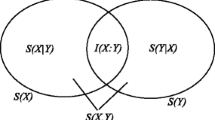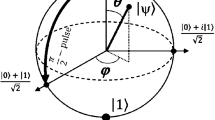Some entangled states have nonnegative Wigner representative function. The latter allow being viewed as a distribution function of local hidden variables. It is argued herewith that the interpretation of expectation values using such distribution functions as local hidden variable theory requires restrictions pertaining to the observables under study. The reasoning lead to support the view that violation of Bell’s inequalities that is always possible for entangled states hinges not only on the states involved but also whether the dynamical variables have their values defined even when they cannot be measured.
Similar content being viewed by others
References
Bell J.S. (1987). Speakable and Unspeakable in Quantum Mechanics. Cambridge University Press, Cambridge, p. 196
M. Revzen, P. Mello, A. Mann, and L. Johanson, Phys. Rev. A 71, 022103 1–11 (2005).
Bell J.S. (1987). Speakable and Unspeakable in Quantum Mechanics. Cambridge University Press, Cambridge, p. 14
Einstein A., Podolsky B., Rosen N. (1935). Phys. Rev. 47:777
Wigner E.P. (1932). Phys. Rev. 40:749
Leonhardt U. (1997). Measuring the Quantum State of Light. Cambridge University Press, Cambridge
Clauser J.F., Shimony A. (1978). Rep. Prog. Phys. 41:1881
Khanna F.C., Mann A., Revzen M., Roy S. (2002). Phys. Lett. A 294:1
Yurke B., Potasek M. (1987). Phys. Rev. A 36:3464
K. Banaszek and K. Wodkiewicz, Phys. Rev. A 58, 4345 (1998); Phys. Rev. Lett. 82, 2009 (1999).
M. Revzen, in Recent Developments in Quantum Physics, Feb. 1–2 (Conference in honor of Asher Peres’s 70th birthday, Technion, Haifa, Israel, 2004).
Clauser J.F., Horne M.A., Shimony A., Holt R.A. (1969). Phys. Rev. Lett. 23:880
Braunstein S.L., Mann A., Revzen M. (1992). Phys. Rev. Lett. 68:3259
Johansen L.M. (1997). Phys. Lett. A 236:173
Reid M.D., Walls D.F. (1986). Phys. Rev. A 34:1260
Walls D.F., Milburn G.J. (1994). Quantum Optics. Springer, Berlin
Grangier P., Potasek M.J., Yurke B. (1988). Phys. Rev. A 38:3132
Kuzmich A., Walmsley I.A., Mandel L. (2002). Phys. Rev. Lett. 85:1349
Ou Z.Y., Pereira S.F., Kimble H.J. (1992). Phys. Rev. Lett. 68:3663
Ou Z.Y., Pereira S.F., Kimble H.J. (1992). App. Phys. B 55:265
Casado A., Marshall T.W., Santos E. (1998). J. Opt. Soc. Am B 15:1572
Zeng-Bing Chen, Jian-Wei Pan Guang Hou, and Yong-De Zhang, Phys. Rev. Lett. 88, 040406 (2002).
Cirelson B.S. (1980). Lett. Math. Phys. 4:93
Landau L.J. (1987). Phys. Lett. A 120:54
In this limit the probability of an even parity state equals that of an odd parity state, cf. Eq. (37). It is for such a state that maximal BIQV is attainable; see, e.g., N. Gisin, Phys. Lett. A 154, 201 (1991).
Gour G., Khanna F.C., Mann A., Revzen M. (2004). Phys. Lett. A 324:415
Examples of alternative domains were considered in J. A. Vaccaro and D. T. Pegg, Phys. Rev. A 41, 5156 (1990); G. S. Agarwal, D. Home, and W. Schleich, Phys. Lett. A 170, 359 (1992).
Wigner E.P. (1970). Am. J. Phys. 38:1005
Sakurai J.J. (1985). Modern Quantum Mechanics, Revised Edition. Addison–Wesley, Reading, MA, p. 227
De Baere W., Mann A., Revzen M. (1999). Found Phys 29:67
Revzen M., Lokajicek M., Mann A. (1997). Quant. Semiclas Opt 9:501
Stapp H. (2004). Am. J. Phys. 72:30
Laloë F. (2001). Am. J. Phys. 69: 655
Schleich W. (2001). Quantum Optics in Phase Space. Wiley-VCH, Berlin, p. 89
R. L. Hudson, Rep. Math. Phys. 6, 249 (1974); W. Schleich, Quantum Optics in Phase Space (Wiley-VCH, Berlin, 2001), p. 74.
M. Moshinsky and C. Quesne, J. Math. Phys. 12, 1772 (1971); J. G. Krüger and A. Poffyn, Physica A 91, 99 (1978).
A nondispersive dynamical variable is not necessarily a proper dynamical variable. The latter should be used as the requirement for hidden variable underpinning whenever distinction arises.
Author information
Authors and Affiliations
Corresponding author
Rights and permissions
About this article
Cite this article
Revzen, M. The Wigner Function as Distribution Function. Found Phys 36, 546–562 (2006). https://doi.org/10.1007/s10701-005-9037-5
Received:
Published:
Issue Date:
DOI: https://doi.org/10.1007/s10701-005-9037-5




